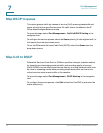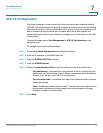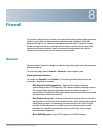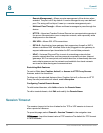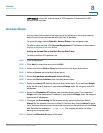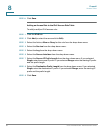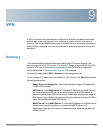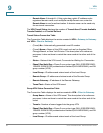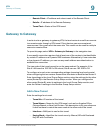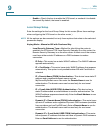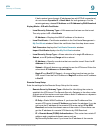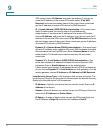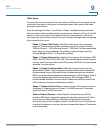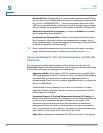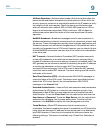
VPN
Summary
82 Cisco RV320/RV325 Administration Guide
9
• Domain Name 1 through 4—If this router has a static IP address and a
registered domain name, such as MyServer.MyDomain.com, enter the
Domain Name to use for authentication. A domain name can be used only
for one tunnel connection.
The VPN Tunnel Status displays the number of Tunnels Used, Tunnels Available,
Tunnels Enabled, and Tunnels Defined.
Tunnel Status Connection Table
The Connection Table displays the entries created in VPN > Gateway to Gateway
and VPN > Client to Gateway:
• (Tunnel) No—Automatically generated tunnel ID number.
• (Tunnel) Name—Name of this VPN tunnel, such as Los Angeles Office,
Chicago Branch, or New York Division. This description is for reference
purposes; it does not have to match the name used at the other end of the
tunnel.
• Status—Status of the VPN tunnel, Connected or Waiting for Connection.
• Phase2 Enc/Auth/Grp—Phase 2 encryption type (NULL/DES/3DES/AES-
128/AES-192/AES-256), authentication method (NULL/MD5/SHA1), and DH
group number (1/2/5).
• Local Group—IP address and subnet mask of the Local Group.
• Remote Group—IP address and subnet mask of the Remote Group.
• Remote Gateway—IP address of the Remote Gateway.
• Tunnel Test—Status of the VPN tunnel.
Group VPN Status Connection Table
The Connection Table displays the entries created in VPN > Client to Gateway:
• Group Name—Name of this VPN tunnel. This description is for reference
purposes; it does not have to match the name used at the other end of the
tunnel.
• Tunnels—Number of users logged into the group VPN.
• Phase2 Enc/Auth/Grp—Phase 2 encryption type (NULL/DES/3DES/AES-
128/AES-192/AES-256), authentication method (NULL/MD5/SHA1), and DH
group number (1/2/5).
• Local Group—IP address and subnet mask of the Local Group.



